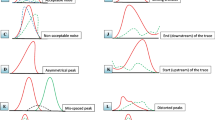Abstract
Introduction
The incorporation of molecular genetic testing into cystic fibrosis (CF) screening programs increases the specificity of the diagnostic strategy and has the potential to decrease the rate of false- positive results. In this sense, our objective was to develop a genotyping assay that could detect 25 pathogenic variants in the cystic fibrosis transmembrane conductance regulator (CFTR) gene with high sensitivity and that could be incorporated into the routine of newborn screening, complementing the current existing protocol used in our public health institution.
Methods
A mini-sequencing assay was standardized using single-base extension in a previously genotyped control sample. This strategy was validated in a Brazilian cohort of CF patients by Sanger sequencing.
Results
The inclusion of the 25 variants in the current newborn screening program increased the identification rates of two alleles from 33 to 52.43% in CF patients. This new approach was able to detect a total of 37 variants, which represents 93.01% of all mutated alleles described in the last CF Brazilian Register.
Conclusions
Mini-sequencing for the simultaneous detection of 25 CFTR gene variants improves the screening of Brazilian newborns and decreases the number of inconclusive cases. This method uses minimal hands-on time and is suited for rapid screening, which reduces sample processing costs.


Similar content being viewed by others
References
O’neal WK, Knowles MR. Cystic fibrosis disease modifiers: complex genetics defines the phenotypic diversity in a monogenic disease. Annu Rev Genom Hum Genet. 2018;19:201–22.
Drumm ML, Pope HA, Cliff WH, et al. Correction of the cystic fibrosis defect in vitro by retrovirus-mediated gene transfer. Cell. 1990;62:1227–33.
Collins FS, Drumm ML, Cole JL, et al. Construction of a general human chromosome jumping library, with application to cystic fibrosis. Science. 1987;235:1046–9.
Castellani C, Assael BM. Cystic fibrosis: a clinical view. Cell Mol Life Sci. 2017;74(1):129–40 (Epub ahead of print).
De Boeck K, Vermeulen F, Dupont L. The diagnosis of cystic fibrosis. Presse Med. 2017;46:e97–108.
Sosnay PR, White TB, Farrell PM, et al. Diagnosis of cystic fibrosis in nonscreened populations. J Pediatr. 2017;181S:S52–S57.e2.
Sathe M, Houwen R. Meconium ileus in cystic fibrosis. J Cyst Fibros. 2017;16(Suppl 2):S32–9.
Castellani C, Massie J, Sontag M, et al. Newborn screening for cystic fibrosis. Lancet Respir Med. 2016;4:653–61.
Rodrigues R, Magalhaes PKR, Fernandes MIM, et al. Neonatal screening for cystic fibrosis in São Paulo State, Brazil: a pilot study. 2009. www.bjournal.com.br. Accessed 2 June 2019.
Athanazio RA, da Silva Filho LVRF, Vergara AA, et al. Brazilian guidelines for the diagnosis and treatment of cystic fibrosis. J Bras Pneumol. 2017;43:219–45.
Servidoni MF, Gomez CCS, Marson FAL, et al. Sweat test and cystic fibrosis: overview of test performance at public and private centers in the state of São Paulo, Brazil. J Bras Pneumol. 2017;43:121–8.
Taylor CJ, Hardcastle J, Southern KW. Physiological measurements confirming the diagnosis of cystic fibrosis: the sweat test and measurements of transepithelial potential difference. Paediatr Respir Rev. 2009;10:220–6.
Farrell PM, Rosenstein BJ, White TB, et al. Guidelines for diagnosis of cystic fibrosis in newborns through older adults: Cystic Fibrosis Foundation consensus report. J Pediatr. 2008;153:S4–14.
Rispoli T, Martins de Castro S, Grandi T, et al. A low-cost and simple genetic screening for cystic fibrosis provided by the Brazilian public health system. J Pediatr. 2018;199:272–7.
Faucz FR, Souza DAS, Olandoski M, et al. CFTR allelic heterogeneity in Brazil: historical and geographical perspectives and implications for screening and counseling for cystic fibrosis in this country. J Hum Genet. 2010;55:71–6.
Mousquer GT, Maciel LP, Pompeu Saraiva AC, et al. Validation of a quick and low-cost DNA extraction protocol applicable to long-stored blood samples. Anal Biochem. 2018;561–562:47–51.
Grupo Brasileiro de Estudos de Fibrose Cística, The Brazilian Cystic Fibrosis Patient Registry, 2016. http://www.gbefc.org.br. Accessed 2 June 2019.
Rodrigues R, Magalhaes PKR, Fernandes CS, et al. Neonatal screening for cystic fibrosis in São Paulo State, Brazil: a pilot study. Braz J Medical Res. 2009;42(10):973–8.
Sih T, Godinho R, Franco LP, et al. Cystic fibrosis: Brazilian ENT experience. Int J Otolaryngol. 2012;2012:204696.
Nunes LM, Ribeiro R, Niewiadonski VDT, et al. A new insight into CFTR allele frequency in Brazil through next generation sequencing. Pediatr Pulmonol. 2017;52:1300–5.
Salinas DB, Sosnay PR, Azen C, et al. Benign and deleterious cystic fibrosis transmembrane conductance regulator mutations identified by sequencing in positive cystic fibrosis newborn screen children from California. PLoS One. 2016;11:e0155624.
Latini FRM, Gazito D, Arnoni CP, et al. A new strategy to identify rare blood donors: single polymerase chain reaction multiplex SNaPshot reaction for detection of 16 blood group alleles. Blood Transfus. 2014;12(Suppl 1):S256–63.
Author information
Authors and Affiliations
Corresponding authors
Ethics declarations
Funding
The study was financed in part by the Coordenação de Aperfeiçoamento de Pessoal de Nível Superior – Brasil (CAPES) (Finance Code 001) and Fundação de Amparo à Pesquisa do Estado do Rio Grande do Sul (FAPERGS) (1260-2551/13-0).
Ethics approval
This study was approved by the ethics committee of the Secretaria da Saúde do Estado do Rio Grande do Sul, Universidade Federal do Rio Grande do Sul, Hospital Materno Infantil Presidente Vargas, Hospital da Criança Santo Antônio, Hospital São Lucas da PUCRS, and Hospital de Clínicas de Porto Alegre.
Patient consent
Obtained.
Conflict of interest
The authors, Thaiane Rispoli, Grazielle M. Rodrigues, Simone M. de Castro, Mayara J. Prado, Cláudia M.D. da Silva, Tarciana Grandi, Gilberto B Fischer, Leonardo A. Pinto, Paulo J.C. Maróstica, Laís C.R. Scortegagna, Helena T. Mocelin, José E. Vargas, and Maria L.R. Rossetti, have no conflict of interest to declare.
Rights and permissions
About this article
Cite this article
Rispoli, T., Rodrigues, G.M., de Castro, S.M. et al. Cystic Fibrosis: A Simple and Customized Strategy for Genetic Screening Able to Detect Over 90% of Identified Mutated Alleles in Brazilian Newborns. Mol Diagn Ther 24, 315–325 (2020). https://doi.org/10.1007/s40291-020-00456-9
Published:
Issue Date:
DOI: https://doi.org/10.1007/s40291-020-00456-9




